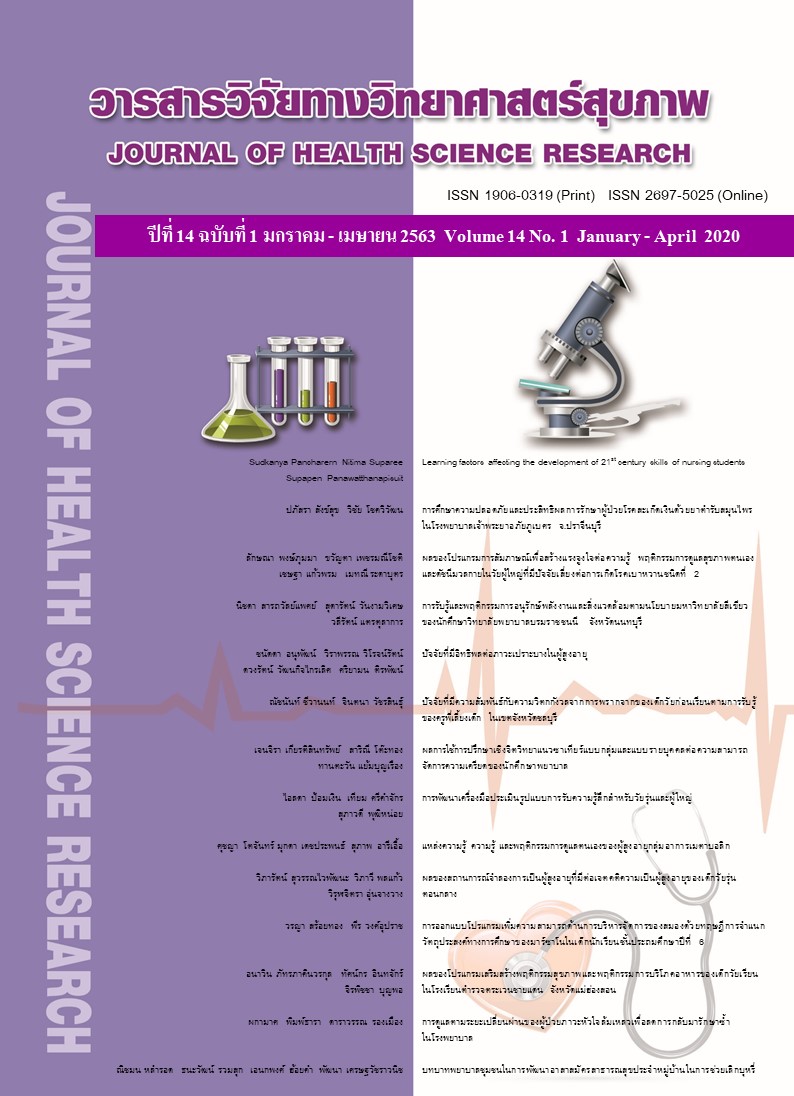Factors influencing frailty in older adults
Main Article Content
Abstract
Objectives: The aim of this research was to study the influence of lifestyle, living environment, and depression on frailty among older adults.
Methods: This study was based on descriptive predictive research, and sampled a total of 301 people older than 60 years and lived in Mueang District, Nakhon Si Thammarat Province. The research instruments included 1) The Demographic Data Questionnaire, 2) The Health Enhancement Lifestyle Profile Screener, 3) The Neighborhood Environment Walkability and the Neighborhood Social Environment Scale, 4) The Thai Geriatric Depression Scale, and 5) The Tilburg Frailty Indicator. Data analysis was performed using binary logistic regression.
Results: The results revealed that most of the participants were female (78.70%), the average age was 70.57 years (SD=7.97), and 33.20% had frailty. According to this study, lifestyle (adjusted OR=4.47, 95%CI 2.44-8.21, p=.00), living environment (adjusted OR= 3.80, 95%CI 2.08-6.92, p=.00) and depression (adjusted OR=8.07, 95%CI 3.56-18.30, p=.00) were found to be able to co-predict frailty among older adults at 41.70% with statistical significance (Nagelkerke R2=41.70, Predictive correct=78.10%, p<.05) by controlling variable of gender, age, level of education, occupation, and income.
Conclusions: Nurses should assess depression, lifestyle, and living environment, and provide appropriate care in order to reduce frailty in older adults.
Downloads
Article Details
บทความที่ได้รับการตีพิมพ์เป็นลิขสิทธิ์ของวิทยาลัยพยาบาลบรมราชชนนี จังหวัดนนทบุรี
ข้อความที่ปรากฏในบทความแต่ละเรื่องในวารสารวิชาการเล่มนี้เป็นความคิดเห็นส่วนตัวของผู้เขียนแต่ละท่านไม่เกี่ยวข้องกับวิทยาลัยพยาบาลบรมราชชนนี จังหวัดนนทบุรี และคณาจารย์ท่านอื่น ในวิทยาลัยฯ แต่อย่างใด ความรับผิดชอบองค์ประกอบทั้งหมดของบทความแต่ละเรื่องเป็นของผู้เขียนแต่ละท่าน หากมีความผิดพลาดใด ๆ ผู้เขียนแต่ละท่านจะรับผิดชอบบทความของตนเองแต่ผู้เดียว
References
World Health Organization. WHO clinical consortium on healthy ageing topic focus: frailty and intrinsic capacity [Internet]. 2017 [Cited 2018 June 1]; Available from: https://apps.who.int/iris/handle/10665/27 2437.
Fried LP, Tangen CM, Walston J, Newman AB, Hirsch C, Gottdiener J, et al. Frailty in older adults: evidence for a phenotype. J Gerontol A Biol Sci Med Sci. 2001;56(3):M146-56.
Gobbens RJJ, Luijkx KG, Wijnen-Sponselee MT, Schols JMGA. Towards an integral conceptual model of frailty. J Nutr Health Aging. 2010;14(3):175-81.
Ofori-Asenso R, Chin KL, Mazidi M, Zomer E, Ilomaki J, Zullo AR, et al. Global incidence of frailty and prefrailty among community-dwelling older adults: a systematic review and meta-analysis. JAMA Netw Open. 2019;2(8):e198398.
Gobbens RJJ, van Assen MA. Associations between multidimensional frailty and quality of life among Dutch older people. Arch Gerontol Geriatr. 2017;73:69-76.
Jaidee S, Sasat S. A study of frailty in older people resided in community, Bangkok. Royal Thai Navy Medical Journal. 2017;44(3):117-35. (in Thai).
Srinonprasert V, Chalermsri C, Aekplakorn W. Frailty index to predict all-cause mortality in Thai community-dwelling older population: A result from a National Health Examination Survey cohort. Arch Gerontol Geriatr. 2018; 77:124-8.
Vermeiren S, Vella-Azzopardi R, Beckwee D, Habbig AK, Scafoglieri A, Jansen B, et al. Frailty and the prediction of negative health outcomes: a meta-analysis. J Am Med Dir Assoc. 2016;17(12):1163.e1-17.
Gobbens RJJ, van Assen MA, Luijkx KG, Wijnen-Sponselee MT, Schols JM. The Tilburg frailty indicator: psychometric properties. J Am Med Dir Assoc. 2010;11(5):344-55.
van Oostrom SH, Rietman ML, Picavet HSJ, Lette M, Verschuren WM, de Bruin SR, et al. A four-domain approach of frailty explored in the Doetinchem Cohort Study. BMC Geriatr. 2017;17(1):196.
Robertson DA, Savva GM, Kenny RA. Frailty and cognitive impairment a review of the evidence and causal mechanisms. Ageing Res Rev. 2013;12(4):840-51.
Pegorari MS, Tavares DMDS. Factors associated with the frailty syndrome in elderly individuals living in the urban area. Rev. Latino-Am. Enfermagem. 2014;22(5):874-82.
Ye B, Gao J, Fu H. Associations between lifestyle, physical and social environments and frailty among Chinese older people: a multilevel analysis. BMC Geriatr. 2018;18(1):314.
Griffiths J, Puttinoi S, Pongsaksri M. The general practitioner assessment of cognition; GPCOG (Thai version): validity and reliability. Poster session presented at 9th Pan-Pacific Conference on Rehabilitation cum. 21st Annual Congress of Gerontology; Hong Kong; 2014.
Hwang JE. Development and validation of a 15-item lifestyle screening for community-dwelling older adults. Am J Occup Ther. 2012;66(6):e98-106.
Brislin RW. Back-translation for cross-cultural research. J Cross-Cult Psychol. 1970;1(3):185-216.
Tiraphat S, Thamma-Aphiphol K, Suthisukon K, Hong SA. Complete research report can a caring environment help the elderly improve their healthy ageing? Know your needs before it's too late. Nakhon Pathom: P.A. Living; 2016. (in Thai).
Wongpakaran N, Wongpakaran T. Prevalence of major depressive disorders and suicide in long term care facilities: a report from northern Thailand. Psychogeriatrics. 2012;12(1):11-7.
Beaton DE, Bombardier C, Guillemin F, Ferraz MB. Guidelines for the process of cross-cultural adaptation of self-report measures. Spine. 2000;25(24):3186-91.
Clegg A, Young J, Iliffe S, Rikkert MO, Rockwood K. Frailty in elderly people. Lancet. 2013;381(9868):752-62.
Etman A, Kamphuis CB, van der Cammen TJ, Burdorf A, van Lenthe FJ. Do lifestyle, health and social participation mediate educational inequalities in frailty worsening?. Eur J Public Health. 2015; 25(2):345-50.

